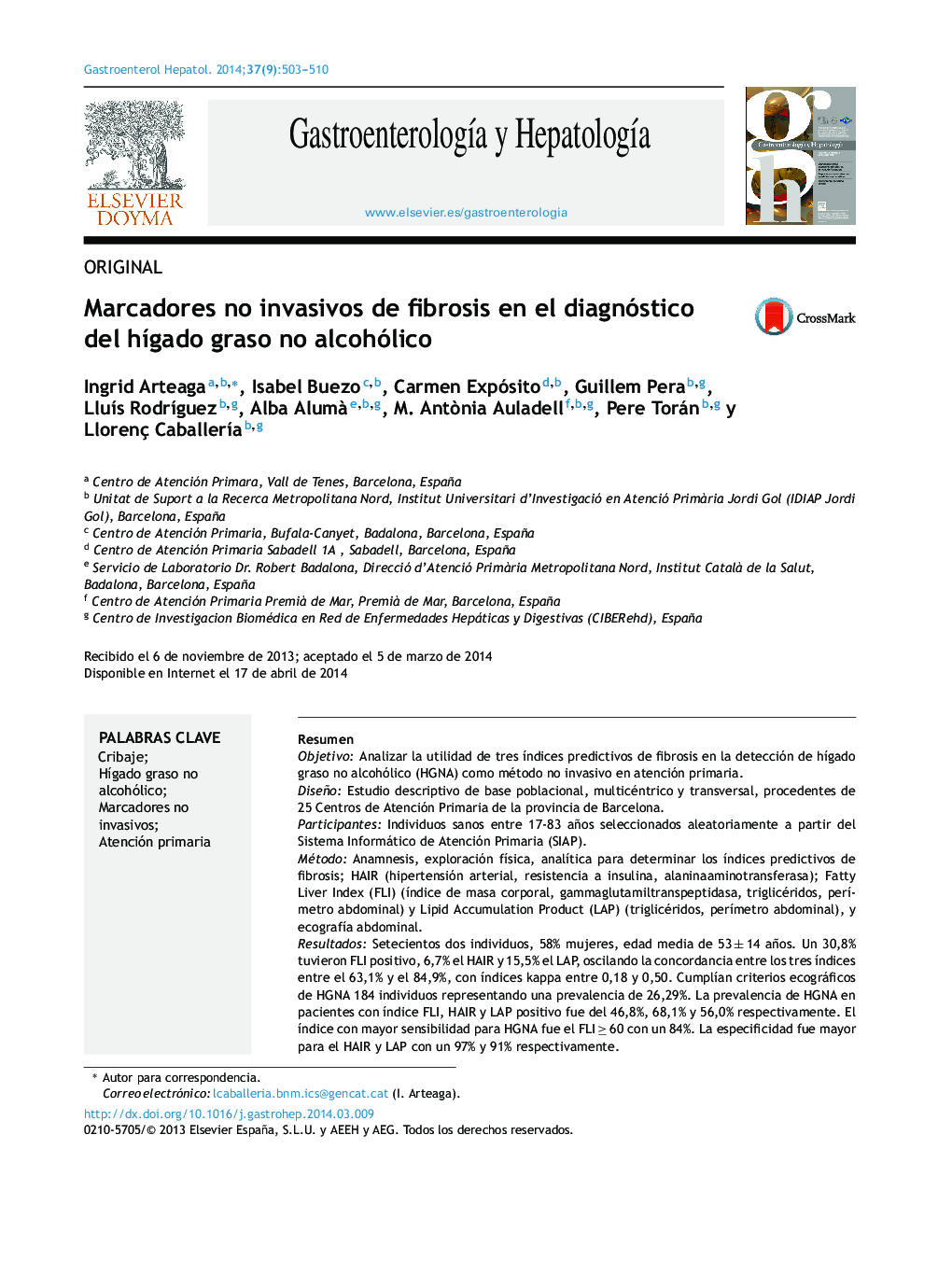| Article ID | Journal | Published Year | Pages | File Type |
|---|---|---|---|---|
| 3288068 | Gastroenterología y Hepatología | 2014 | 8 Pages |
ResumenObjetivoAnalizar la utilidad de tres índices predictivos de fibrosis en la detección de hígado graso no alcohólico (HGNA) como método no invasivo en atención primaria.DiseñoEstudio descriptivo de base poblacional, multicéntrico y transversal, procedentes de 25 Centros de Atención Primaria de la provincia de Barcelona.ParticipantesIndividuos sanos entre 17-83 años seleccionados aleatoriamente a partir del Sistema Informático de Atención Primaria (SIAP).MétodoAnamnesis, exploración física, analítica para determinar los índices predictivos de fibrosis; HAIR (hipertensión arterial, resistencia a insulina, alaninaaminotransferasa); Fatty Liver Index (FLI) (índice de masa corporal, gammaglutamiltranspeptidasa, triglicéridos, perímetro abdominal) y Lipid Accumulation Product (LAP) (triglicéridos, perímetro abdominal), y ecografía abdominal.ResultadosSetecientos dos individuos, 58% mujeres, edad media de 53 ± 14 años. Un 30,8% tuvieron FLI positivo, 6,7% el HAIR y 15,5% el LAP, oscilando la concordancia entre los tres índices entre el 63,1% y el 84,9%, con índices kappa entre 0,18 y 0,50. Cumplían criterios ecográficos de HGNA 184 individuos representando una prevalencia de 26,29%. La prevalencia de HGNA en pacientes con índice FLI, HAIR y LAP positivo fue del 46,8%, 68,1% y 56,0% respectivamente. El índice con mayor sensibilidad para HGNA fue el FLI ≥ 60 con un 84%. La especificidad fue mayor para el HAIR y LAP con un 97% y 91% respectivamente.ConclusionesFLI, HAIR y LAP son muy prevalentes y se han mostrado como marcadores independientes para el diagnóstico de HGNA. La falta de concordancia entre estos índices, provoca la obtención de diferentes prevalencias siendo necesario unificar criterios para obtener un índice más útil para el diagnóstico de HGNA.
ObjectiveTo analyze the utility of three indices to predict hepatic fibrosis in the detection of non-alcoholic fatty liver disease (NAFLD) as a non-invasive method in primary care.DesignWe performed a descriptive, cross-sectional, multicenter study with a populational base from 25 primary care centers in the province of Barcelona.ParticipantsHealthy individuals aged 17 to 83 years randomly selected from the Primary Care Computer System.MethodsMedical history, physical examination, and blood analyses were used to determine the following predictive indices of fibrosis; HAIR (hypertension, alanine-aminotransferase, insulin resistance); Fatty Liver Index (FLI) (body mass index, gammaglutamyl-transpeptidase, triglycerides, abdominal perimeter) and Lipid Accumulation Product (LAP) (triglycerides, abdominal perimeter), and abdominal echography.ResultsWe included 702 individuals; 58% were women and the mean age was 53 ± 14 years. The FLI was positive in 30.8%, HAIR was positive in 6.7%, and LAP was positive in 15.5%. Agreement among the three indices ranged from 63.1% to 84.9%, with kappa indices between 0.18 and 0.50. A total of 184 individuals met the echographic criteria of NAFLD, representing a prevalence of 26.29%. The prevalence of NAFLD in patients with positive FLI, HAIR and LAP indices was 46.8%, 68.1% and 56%, respectively. The index with the greatest sensitivity for NAFLD was tFLI ≥ 60 with 84%. Specificity was highest for HAIR and LAP with 97% and 91%, respectively.ConclusionsFLI, HAIR and LAP are highly prevalent and have been shown to be independent markers for the diagnosis of NAFLD. Because of the lack of concordance between the indices, different prevalences are obtained, thus requiring criteria to be unified in order to obtain a more useful index for the diagnosis of NAFLD.
